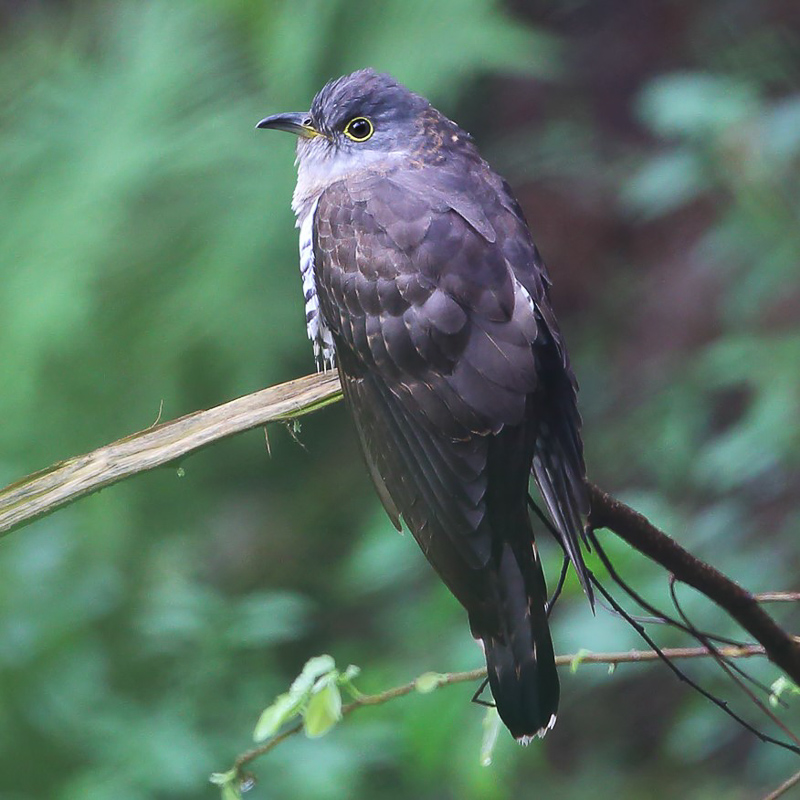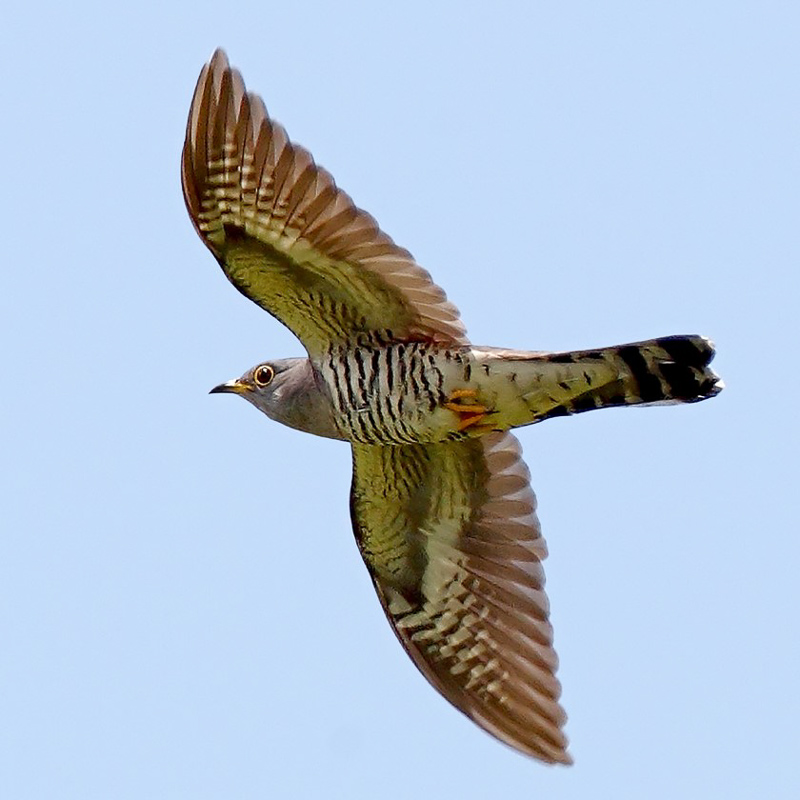Indian Cuckoo Cuculus micropterus 四聲杜鵑
Category I. Breeding summer visitor, which is locally common but less widespread than in the past.
IDENTIFICATION

Apr. 2016, Michelle and Peter Wong. Adult.
38-40 cm. A medium-sized cuckoo, which, if not calling, is most easily distinguished from other similar species by its broad black subterminal tail band. It also has a relatively large eye, a yellow eye-ring and reddish-brown iris. Adult males have a greyish head and throat that contrasts with the brownish-tinged upperparts, a paler grey head, neck and upper breast and whitish underparts with broad blackish, often incomplete bars. Females are browner above and on the breast. Recently-fledged juveniles have extensive white spotting on the head and hindneck (Becking 1981).

May. 2011, Michelle and Peter Wong. Adult.
In the breeding area it is frequently seen in flight when it often vocalises. Adults have broad, widely-spaced barring on the underparts.
VOCALISATIONS
The male territorial call is a far-carrying, fluty, four-note phrase ‘whi-whi-whi-whu’ (sometimes rendered in English as “one more bottle”), the final note slightly lower in pitch.
The female gives a bubbling call, often in flight.
DISTRIBUTION & HABITAT PREFERENCE
Recorded in all areas and at all elevations but is most widespread in the lowlands of the northwest New Territories and Lantau. Favoured habitats are pines and casuarinas on poorly vegetated hillsides (now rapidly being replaced by closed canopy shrubland) and tall stands of trees, including fung shui woods, and those at the edge of marshes, fishponds, farmland, golf courses and other open areas; it is also occasionally found at the edge of forest or in mangroves.
OCCURRENCE
Indian Cuckoo has been recorded between 10 March and 7 September (Figure 1), with a further record of a sick or injured bird on 6 October 2015. Nearly all records up to 1 August refer to birds giving the territorial call. Records in April-May account for 87% of the total.
Numbers build rapidly in April to reach a peak in the third week of the month, and then decline steadily in May and more steeply in June. Outside of these months, there are only three records in March, four in July, two in August and three in September. Most reports are of one or two birds; the highest count is 11 at Nam Sang Wai on 18 April 2018. Mimicry by other species, especially Black-throated Laughingthrush, is thought to account for a number of reports of unseen birds on unusual dates.
A distributional decline has occurred since the 1990s, with the percentage of 1 km grid squares in which it was recorded falling from 21.1% in the breeding bird survey of 1993-1996 to 5.5% in that of 2016-2019. Although differences in methodology between the two surveys may be a factor, the decline is considered to be genuine and is most marked in the hills of the eastern New Territories, HK Island, Lantau and Lamma, where large areas which were at one time poorly vegetated are now covered with dense shrubland.
Following records in Macau and adjacent parts of southern Guangdong in the early 1900s (Kershaw 1904, Vaughan and Jones 1913), a report of six birds in the Lam Tsuen Valley on 13 April 1932 (Aylmer 1932) was the first to refer explicitly to HK. Herklots (1938, 1953) noted birds singing persistently day and night from the third week of April to the end of May, and then less frequently in June; they were thought to depart in October. From the 1960s to the 1990s, it was generally regarded as a common or fairly common breeding summer visitor.
BEHAVIOUR, FORAGING & DIET
Males in the breeding season may sing for long periods day and night and in fine weather or rain, usually from a tree top, sometimes also in flight, but otherwise remain within tree cover and are rather secretive. Caterpillars are the only food item noted in HK.
BREEDING
There are four records of Indian Cuckoo nestlings in HK, all in the period 9-16 June and five records of recently fledged young, all 18 June to 10 August. The nestlings, all singles in the nests of Black Drongo, were recorded on 10 June 1959, in early June 1970, on 16 June 2006 and on 9 June 2015. Black Drongo is a known host species in Macao (Kershaw 1904, Steinheimer et al. 2003) and southern Guangdong (Vaughan & Jones 1913). The recently fledged juveniles, if not unattended, were all being fed or closely attended by Black Drongos.
RANGE & SYSTEMATICS
Polytypic. The nominate subspecies breeds from India east to Burma and north Indochina through much of China to southeast Siberia, Ussuriland and Korea, with northern populations wintering south to the Greater Sundas and the Philippines; subspecies concretus is resident from southern Thailand south to the Greater Sundas (Payne 1997). The distribution in continental China outlined by Cheng (1987) lies southeast of a line from Yunnan to Inner Mongolia and Heilongjiang.
CONSERVATION STATUS
IUCN: Least Concern. Population trend decreasing.
Figure 1.

Aylmer, E. A. (1932). Notes and comments. Ornithology. Hong Kong Naturalist 3: 145-151.
Becking, J. H. (1981). Notes on the breeding of Indian cuckoos. Journal of the Bombay Natural History Society 78: 201-231.
Cheng, T. H. (1987). A Synopsis of the Avifauna of China. Science Press, Beijing.
Kershaw, J. C. (1904). List of the Birds of the Quangtung Coast, China. Ibis 1904: 235-248.
Herklots, G. A. C. (1938). The birds of Hong Kong. Part XXX. Family Cuculidae. Hong Kong Naturalist 9: 1-3.
Herklots, G. A. C. (1953). Hong Kong Birds. South China Morning Post, Hong Kong.
Payne, R. B. (1997). Family Cuculidae (Cuckoos) in del Hoyo, J., Elliot, A. and J. Sargatal. Handbook of the Birds of the World, vol. 4: Sandgrouse to Cuckoos. Lynx Edicions, Barcelona, Spain.

